Project Risk and Procurement Management: Case Study and Analysis
VerifiedAdded on 2020/03/28
|20
|5204
|405
Report
AI Summary
This report delves into the critical domains of project risk and procurement management, emphasizing their significance in aligning organizational objectives with strategic plans. It underscores the inherent uncertainties in projects and the need for comprehensive risk management processes, encompassing risk identification, analysis, response, and monitoring. The report uses Compass Group Limited as a case study to analyze how companies can adopt effective risk evaluation processes. The report further examines theoretical frameworks, including the financial economics theory, and explores the impact of risk on project success, including project risk, risk attitude, and the strategy of managing project risk. It highlights the importance of proactive risk management strategies to minimize negative impacts and maximize project outcomes, providing a holistic view of project management in a globalized business environment. The report also emphasizes the importance of risk management in ensuring project success and minimizing potential losses.
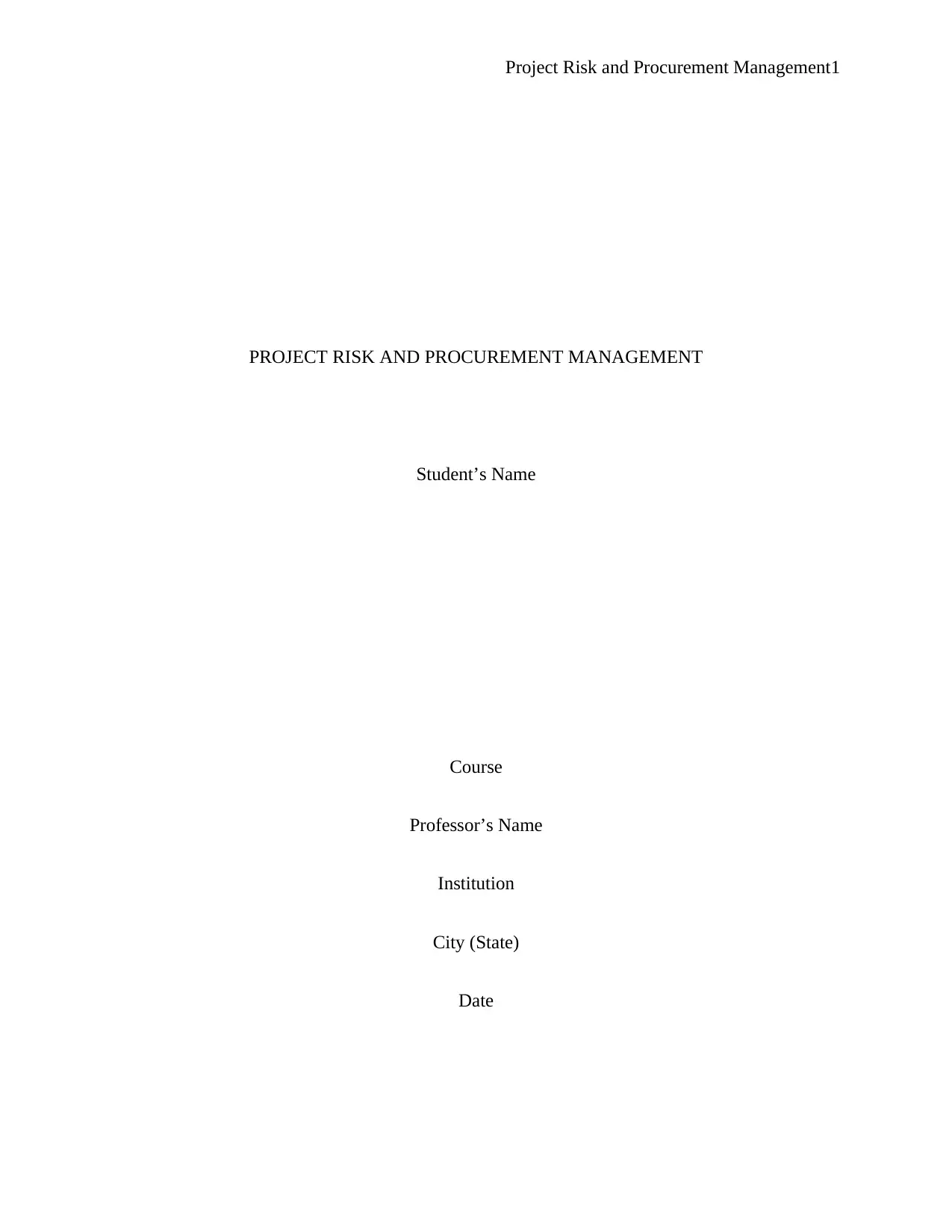
Project Risk and Procurement Management1
PROJECT RISK AND PROCUREMENT MANAGEMENT
Student’s Name
Course
Professor’s Name
Institution
City (State)
Date
PROJECT RISK AND PROCUREMENT MANAGEMENT
Student’s Name
Course
Professor’s Name
Institution
City (State)
Date
Paraphrase This Document
Need a fresh take? Get an instant paraphrase of this document with our AI Paraphraser

Project Risk and Procurement Management2
Abstract
For an organization to align its objectives with its strategic plans, it has to engage in
different projects. Evidently, they play competent roles in the success of a company and thus
they should not only be prioritized, but also they should be carried out with a lot of care.
Although different organizations have been directing much of their attention to completing
certain projects, evidence shows that they are at some point exposed to an increased level of
uncertainty. It impacts the project performance while also influencing the overall plan of the
organization. Risk, which is the uncertainty, can be defined as the possibility of the occurrence of
accidents or events that alter entire the goals of an organization. According to the Enterprise Risk
management Initiative Staff (2004), the management of risk is not a linear process, but efficient
risk management practices can comprehend the many factors that connect each other in sets. The
aspect of globalization has expanded the global market, hence increasing the competitive
advantage of states. Besides, differences in religion, culture and even values mirror the global
sourcing. The varied decisions that companies make hold unforeseen consequences, which
expose their projects to unexpected risks. Following the need to address huge losses that relate to
finances, time and people, it is imperative to examine the concept of risk management. All
projects should be evaluated for risks since failure to identify and eliminate them could lead to
major losses both in the short-term and long-term. It is thus a mandatory for organizations to
follow the entire risk management process, which includes risk identification, risk analysis, risk
response, and risk monitoring and control to mitigate and even eliminate risks. In such case,
projects and companies will be guaranteed success.
Abstract
For an organization to align its objectives with its strategic plans, it has to engage in
different projects. Evidently, they play competent roles in the success of a company and thus
they should not only be prioritized, but also they should be carried out with a lot of care.
Although different organizations have been directing much of their attention to completing
certain projects, evidence shows that they are at some point exposed to an increased level of
uncertainty. It impacts the project performance while also influencing the overall plan of the
organization. Risk, which is the uncertainty, can be defined as the possibility of the occurrence of
accidents or events that alter entire the goals of an organization. According to the Enterprise Risk
management Initiative Staff (2004), the management of risk is not a linear process, but efficient
risk management practices can comprehend the many factors that connect each other in sets. The
aspect of globalization has expanded the global market, hence increasing the competitive
advantage of states. Besides, differences in religion, culture and even values mirror the global
sourcing. The varied decisions that companies make hold unforeseen consequences, which
expose their projects to unexpected risks. Following the need to address huge losses that relate to
finances, time and people, it is imperative to examine the concept of risk management. All
projects should be evaluated for risks since failure to identify and eliminate them could lead to
major losses both in the short-term and long-term. It is thus a mandatory for organizations to
follow the entire risk management process, which includes risk identification, risk analysis, risk
response, and risk monitoring and control to mitigate and even eliminate risks. In such case,
projects and companies will be guaranteed success.
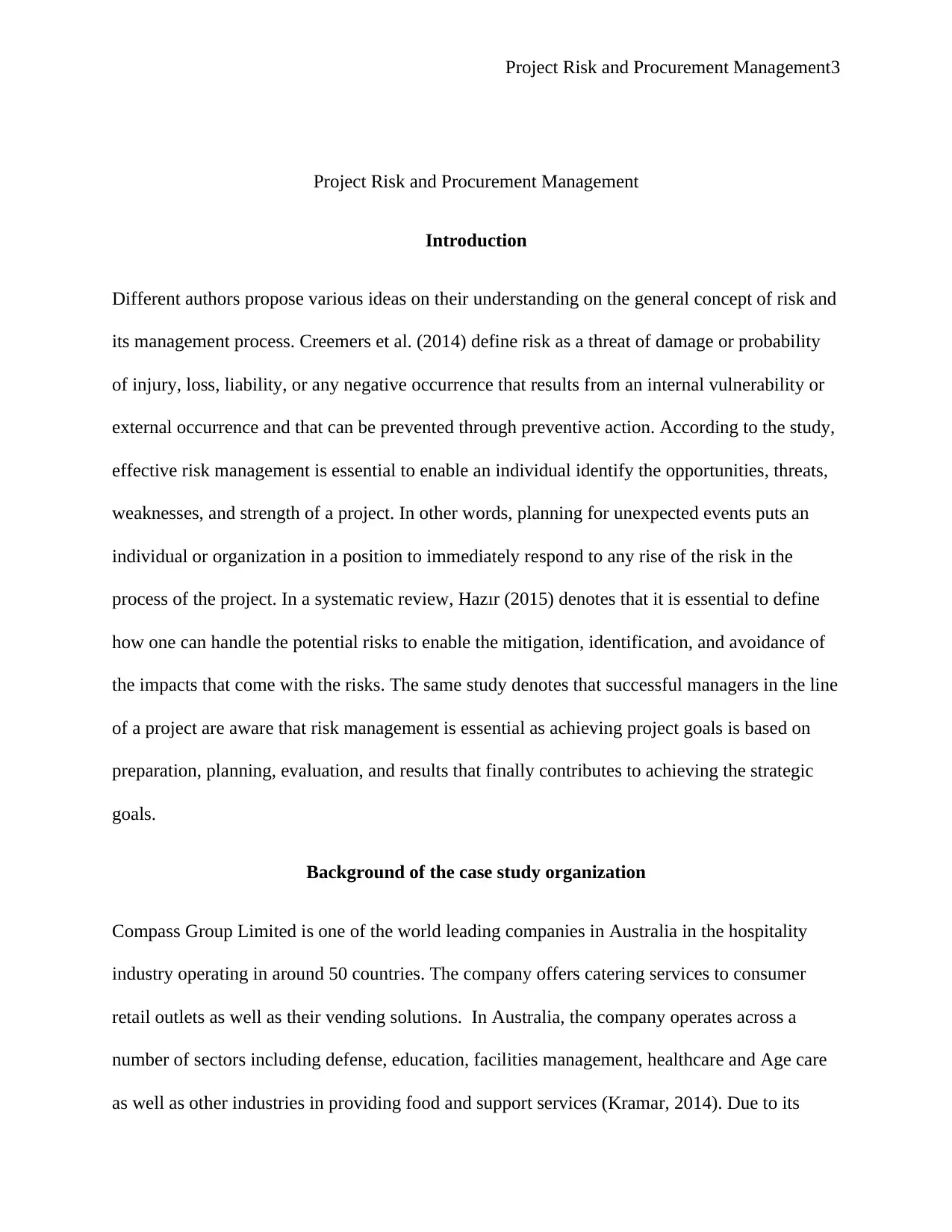
Project Risk and Procurement Management3
Project Risk and Procurement Management
Introduction
Different authors propose various ideas on their understanding on the general concept of risk and
its management process. Creemers et al. (2014) define risk as a threat of damage or probability
of injury, loss, liability, or any negative occurrence that results from an internal vulnerability or
external occurrence and that can be prevented through preventive action. According to the study,
effective risk management is essential to enable an individual identify the opportunities, threats,
weaknesses, and strength of a project. In other words, planning for unexpected events puts an
individual or organization in a position to immediately respond to any rise of the risk in the
process of the project. In a systematic review, Hazır (2015) denotes that it is essential to define
how one can handle the potential risks to enable the mitigation, identification, and avoidance of
the impacts that come with the risks. The same study denotes that successful managers in the line
of a project are aware that risk management is essential as achieving project goals is based on
preparation, planning, evaluation, and results that finally contributes to achieving the strategic
goals.
Background of the case study organization
Compass Group Limited is one of the world leading companies in Australia in the hospitality
industry operating in around 50 countries. The company offers catering services to consumer
retail outlets as well as their vending solutions. In Australia, the company operates across a
number of sectors including defense, education, facilities management, healthcare and Age care
as well as other industries in providing food and support services (Kramar, 2014). Due to its
Project Risk and Procurement Management
Introduction
Different authors propose various ideas on their understanding on the general concept of risk and
its management process. Creemers et al. (2014) define risk as a threat of damage or probability
of injury, loss, liability, or any negative occurrence that results from an internal vulnerability or
external occurrence and that can be prevented through preventive action. According to the study,
effective risk management is essential to enable an individual identify the opportunities, threats,
weaknesses, and strength of a project. In other words, planning for unexpected events puts an
individual or organization in a position to immediately respond to any rise of the risk in the
process of the project. In a systematic review, Hazır (2015) denotes that it is essential to define
how one can handle the potential risks to enable the mitigation, identification, and avoidance of
the impacts that come with the risks. The same study denotes that successful managers in the line
of a project are aware that risk management is essential as achieving project goals is based on
preparation, planning, evaluation, and results that finally contributes to achieving the strategic
goals.
Background of the case study organization
Compass Group Limited is one of the world leading companies in Australia in the hospitality
industry operating in around 50 countries. The company offers catering services to consumer
retail outlets as well as their vending solutions. In Australia, the company operates across a
number of sectors including defense, education, facilities management, healthcare and Age care
as well as other industries in providing food and support services (Kramar, 2014). Due to its
⊘ This is a preview!⊘
Do you want full access?
Subscribe today to unlock all pages.

Trusted by 1+ million students worldwide
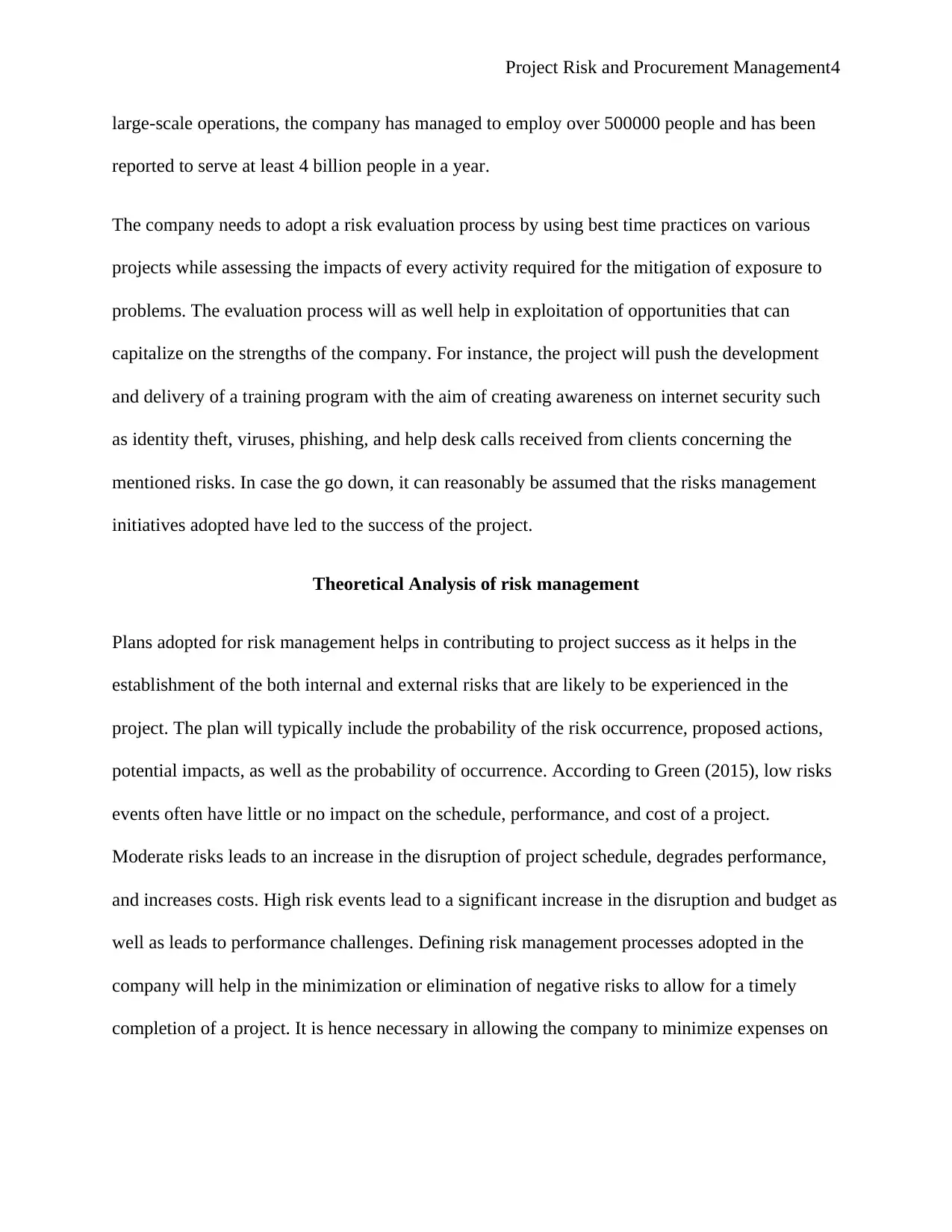
Project Risk and Procurement Management4
large-scale operations, the company has managed to employ over 500000 people and has been
reported to serve at least 4 billion people in a year.
The company needs to adopt a risk evaluation process by using best time practices on various
projects while assessing the impacts of every activity required for the mitigation of exposure to
problems. The evaluation process will as well help in exploitation of opportunities that can
capitalize on the strengths of the company. For instance, the project will push the development
and delivery of a training program with the aim of creating awareness on internet security such
as identity theft, viruses, phishing, and help desk calls received from clients concerning the
mentioned risks. In case the go down, it can reasonably be assumed that the risks management
initiatives adopted have led to the success of the project.
Theoretical Analysis of risk management
Plans adopted for risk management helps in contributing to project success as it helps in the
establishment of the both internal and external risks that are likely to be experienced in the
project. The plan will typically include the probability of the risk occurrence, proposed actions,
potential impacts, as well as the probability of occurrence. According to Green (2015), low risks
events often have little or no impact on the schedule, performance, and cost of a project.
Moderate risks leads to an increase in the disruption of project schedule, degrades performance,
and increases costs. High risk events lead to a significant increase in the disruption and budget as
well as leads to performance challenges. Defining risk management processes adopted in the
company will help in the minimization or elimination of negative risks to allow for a timely
completion of a project. It is hence necessary in allowing the company to minimize expenses on
large-scale operations, the company has managed to employ over 500000 people and has been
reported to serve at least 4 billion people in a year.
The company needs to adopt a risk evaluation process by using best time practices on various
projects while assessing the impacts of every activity required for the mitigation of exposure to
problems. The evaluation process will as well help in exploitation of opportunities that can
capitalize on the strengths of the company. For instance, the project will push the development
and delivery of a training program with the aim of creating awareness on internet security such
as identity theft, viruses, phishing, and help desk calls received from clients concerning the
mentioned risks. In case the go down, it can reasonably be assumed that the risks management
initiatives adopted have led to the success of the project.
Theoretical Analysis of risk management
Plans adopted for risk management helps in contributing to project success as it helps in the
establishment of the both internal and external risks that are likely to be experienced in the
project. The plan will typically include the probability of the risk occurrence, proposed actions,
potential impacts, as well as the probability of occurrence. According to Green (2015), low risks
events often have little or no impact on the schedule, performance, and cost of a project.
Moderate risks leads to an increase in the disruption of project schedule, degrades performance,
and increases costs. High risk events lead to a significant increase in the disruption and budget as
well as leads to performance challenges. Defining risk management processes adopted in the
company will help in the minimization or elimination of negative risks to allow for a timely
completion of a project. It is hence necessary in allowing the company to minimize expenses on
Paraphrase This Document
Need a fresh take? Get an instant paraphrase of this document with our AI Paraphraser
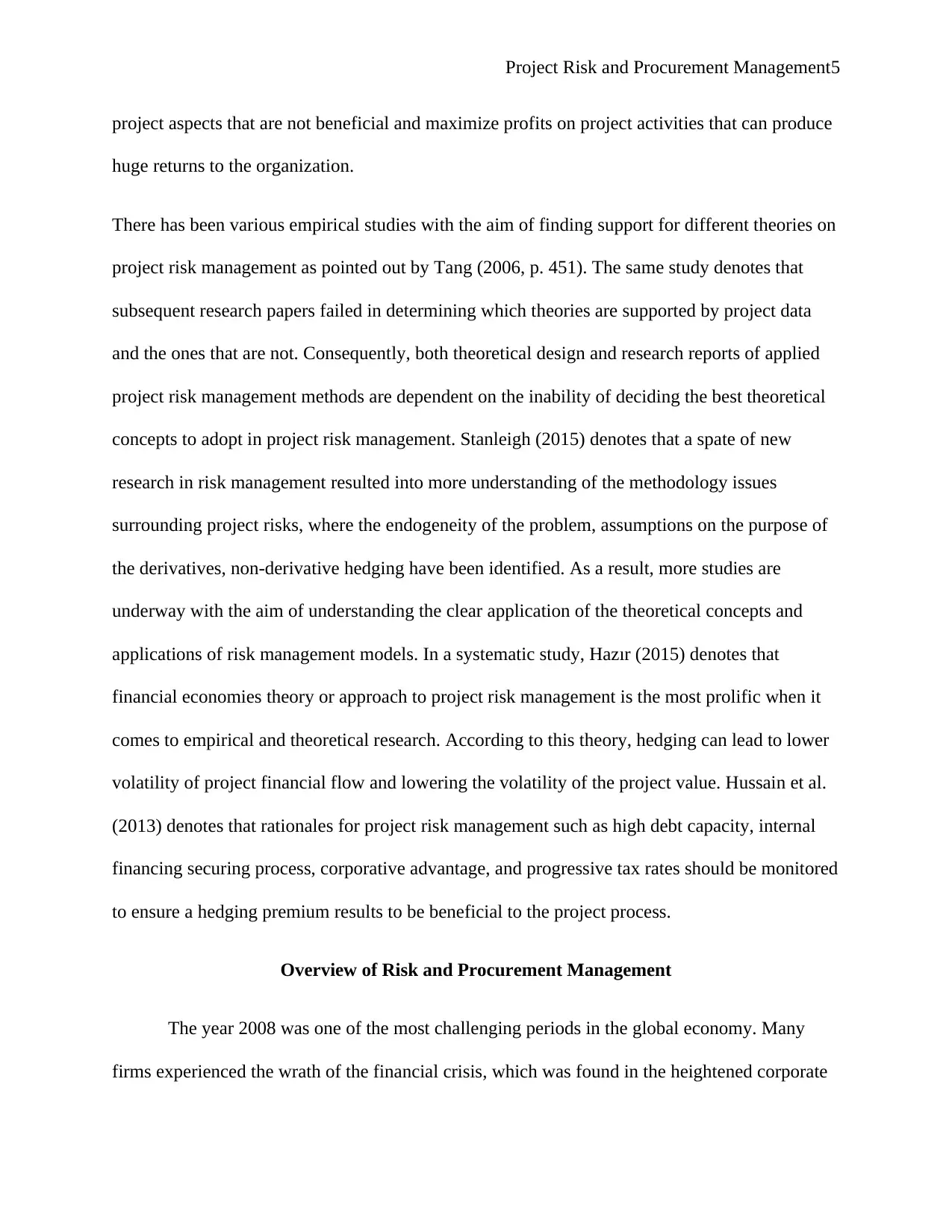
Project Risk and Procurement Management5
project aspects that are not beneficial and maximize profits on project activities that can produce
huge returns to the organization.
There has been various empirical studies with the aim of finding support for different theories on
project risk management as pointed out by Tang (2006, p. 451). The same study denotes that
subsequent research papers failed in determining which theories are supported by project data
and the ones that are not. Consequently, both theoretical design and research reports of applied
project risk management methods are dependent on the inability of deciding the best theoretical
concepts to adopt in project risk management. Stanleigh (2015) denotes that a spate of new
research in risk management resulted into more understanding of the methodology issues
surrounding project risks, where the endogeneity of the problem, assumptions on the purpose of
the derivatives, non-derivative hedging have been identified. As a result, more studies are
underway with the aim of understanding the clear application of the theoretical concepts and
applications of risk management models. In a systematic study, Hazır (2015) denotes that
financial economies theory or approach to project risk management is the most prolific when it
comes to empirical and theoretical research. According to this theory, hedging can lead to lower
volatility of project financial flow and lowering the volatility of the project value. Hussain et al.
(2013) denotes that rationales for project risk management such as high debt capacity, internal
financing securing process, corporative advantage, and progressive tax rates should be monitored
to ensure a hedging premium results to be beneficial to the project process.
Overview of Risk and Procurement Management
The year 2008 was one of the most challenging periods in the global economy. Many
firms experienced the wrath of the financial crisis, which was found in the heightened corporate
project aspects that are not beneficial and maximize profits on project activities that can produce
huge returns to the organization.
There has been various empirical studies with the aim of finding support for different theories on
project risk management as pointed out by Tang (2006, p. 451). The same study denotes that
subsequent research papers failed in determining which theories are supported by project data
and the ones that are not. Consequently, both theoretical design and research reports of applied
project risk management methods are dependent on the inability of deciding the best theoretical
concepts to adopt in project risk management. Stanleigh (2015) denotes that a spate of new
research in risk management resulted into more understanding of the methodology issues
surrounding project risks, where the endogeneity of the problem, assumptions on the purpose of
the derivatives, non-derivative hedging have been identified. As a result, more studies are
underway with the aim of understanding the clear application of the theoretical concepts and
applications of risk management models. In a systematic study, Hazır (2015) denotes that
financial economies theory or approach to project risk management is the most prolific when it
comes to empirical and theoretical research. According to this theory, hedging can lead to lower
volatility of project financial flow and lowering the volatility of the project value. Hussain et al.
(2013) denotes that rationales for project risk management such as high debt capacity, internal
financing securing process, corporative advantage, and progressive tax rates should be monitored
to ensure a hedging premium results to be beneficial to the project process.
Overview of Risk and Procurement Management
The year 2008 was one of the most challenging periods in the global economy. Many
firms experienced the wrath of the financial crisis, which was found in the heightened corporate
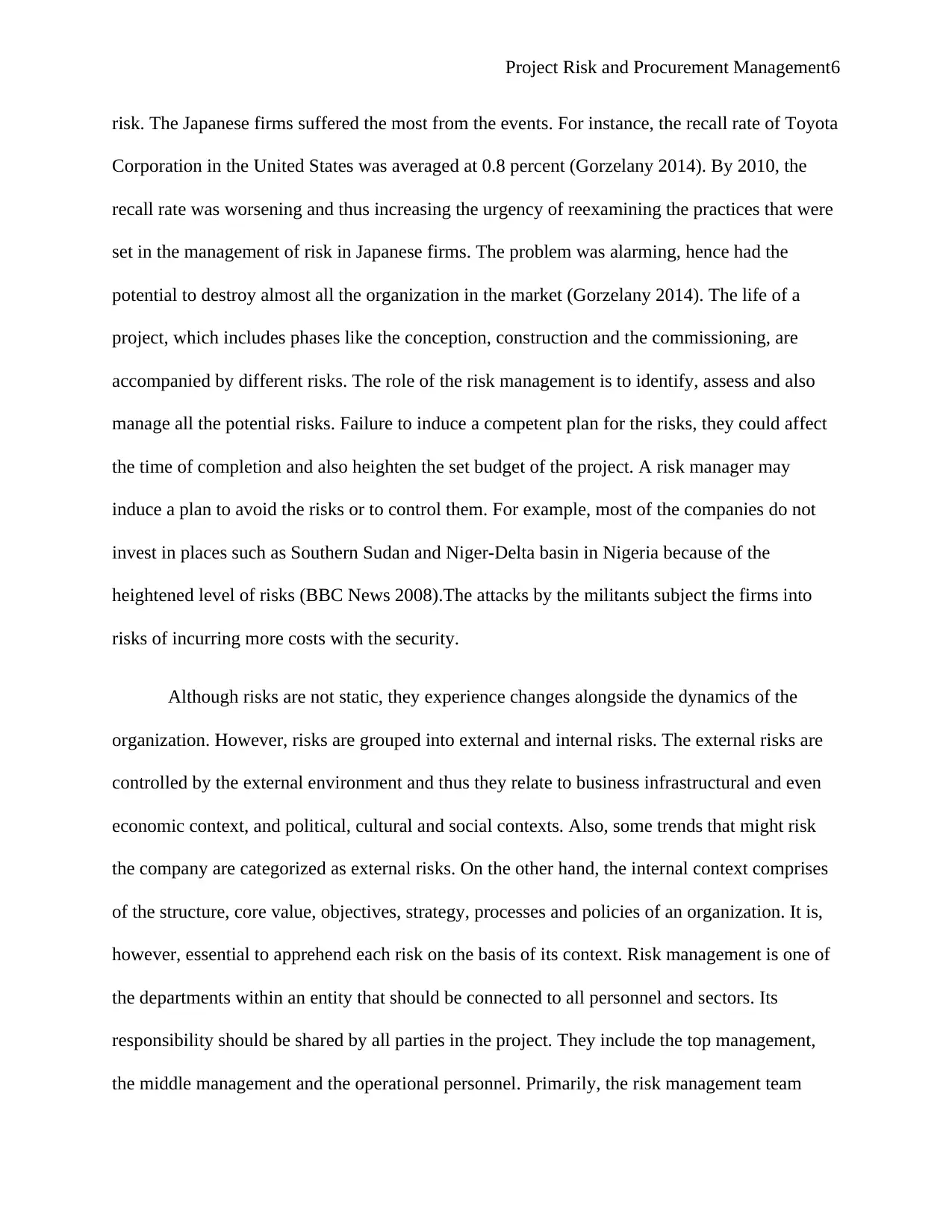
Project Risk and Procurement Management6
risk. The Japanese firms suffered the most from the events. For instance, the recall rate of Toyota
Corporation in the United States was averaged at 0.8 percent (Gorzelany 2014). By 2010, the
recall rate was worsening and thus increasing the urgency of reexamining the practices that were
set in the management of risk in Japanese firms. The problem was alarming, hence had the
potential to destroy almost all the organization in the market (Gorzelany 2014). The life of a
project, which includes phases like the conception, construction and the commissioning, are
accompanied by different risks. The role of the risk management is to identify, assess and also
manage all the potential risks. Failure to induce a competent plan for the risks, they could affect
the time of completion and also heighten the set budget of the project. A risk manager may
induce a plan to avoid the risks or to control them. For example, most of the companies do not
invest in places such as Southern Sudan and Niger-Delta basin in Nigeria because of the
heightened level of risks (BBC News 2008).The attacks by the militants subject the firms into
risks of incurring more costs with the security.
Although risks are not static, they experience changes alongside the dynamics of the
organization. However, risks are grouped into external and internal risks. The external risks are
controlled by the external environment and thus they relate to business infrastructural and even
economic context, and political, cultural and social contexts. Also, some trends that might risk
the company are categorized as external risks. On the other hand, the internal context comprises
of the structure, core value, objectives, strategy, processes and policies of an organization. It is,
however, essential to apprehend each risk on the basis of its context. Risk management is one of
the departments within an entity that should be connected to all personnel and sectors. Its
responsibility should be shared by all parties in the project. They include the top management,
the middle management and the operational personnel. Primarily, the risk management team
risk. The Japanese firms suffered the most from the events. For instance, the recall rate of Toyota
Corporation in the United States was averaged at 0.8 percent (Gorzelany 2014). By 2010, the
recall rate was worsening and thus increasing the urgency of reexamining the practices that were
set in the management of risk in Japanese firms. The problem was alarming, hence had the
potential to destroy almost all the organization in the market (Gorzelany 2014). The life of a
project, which includes phases like the conception, construction and the commissioning, are
accompanied by different risks. The role of the risk management is to identify, assess and also
manage all the potential risks. Failure to induce a competent plan for the risks, they could affect
the time of completion and also heighten the set budget of the project. A risk manager may
induce a plan to avoid the risks or to control them. For example, most of the companies do not
invest in places such as Southern Sudan and Niger-Delta basin in Nigeria because of the
heightened level of risks (BBC News 2008).The attacks by the militants subject the firms into
risks of incurring more costs with the security.
Although risks are not static, they experience changes alongside the dynamics of the
organization. However, risks are grouped into external and internal risks. The external risks are
controlled by the external environment and thus they relate to business infrastructural and even
economic context, and political, cultural and social contexts. Also, some trends that might risk
the company are categorized as external risks. On the other hand, the internal context comprises
of the structure, core value, objectives, strategy, processes and policies of an organization. It is,
however, essential to apprehend each risk on the basis of its context. Risk management is one of
the departments within an entity that should be connected to all personnel and sectors. Its
responsibility should be shared by all parties in the project. They include the top management,
the middle management and the operational personnel. Primarily, the risk management team
⊘ This is a preview!⊘
Do you want full access?
Subscribe today to unlock all pages.

Trusted by 1+ million students worldwide
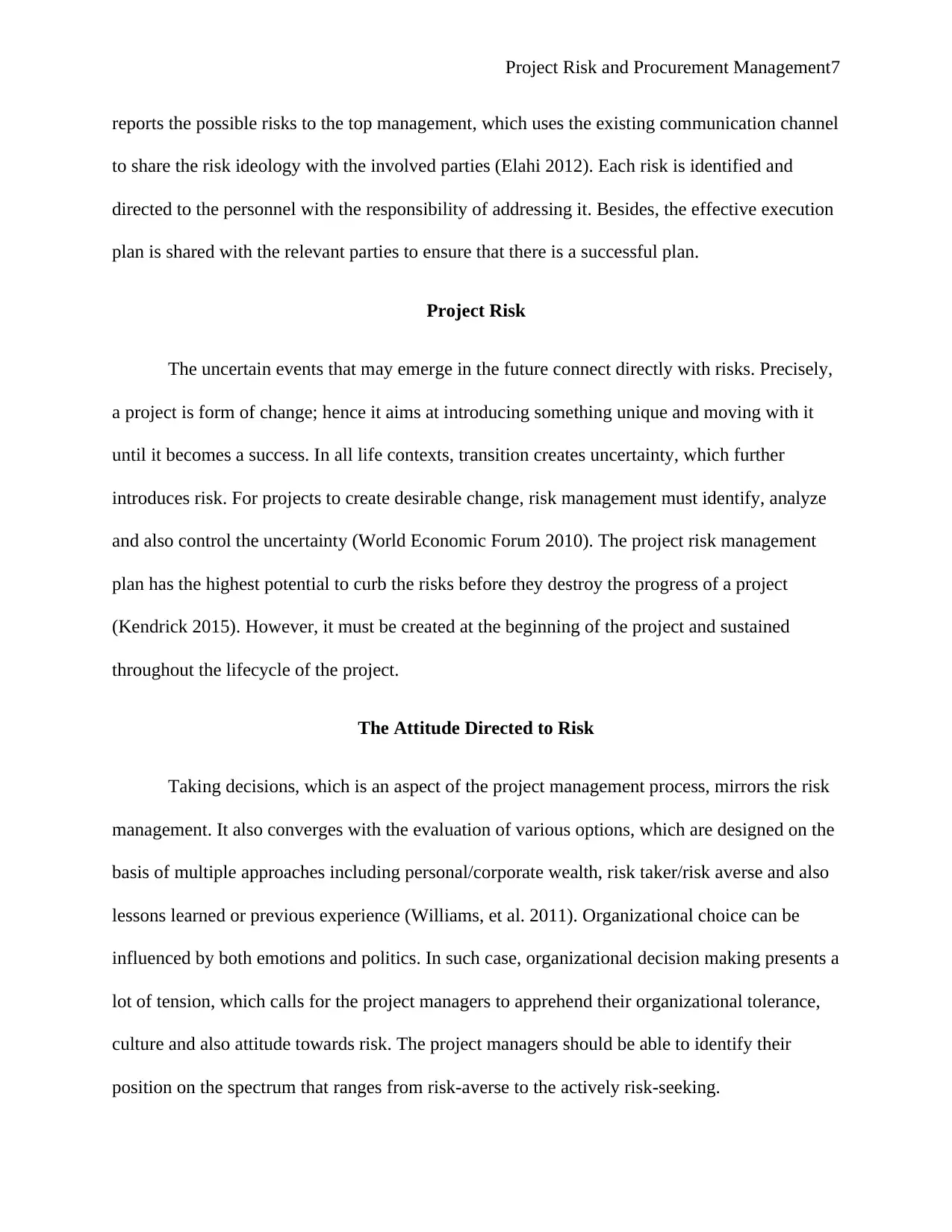
Project Risk and Procurement Management7
reports the possible risks to the top management, which uses the existing communication channel
to share the risk ideology with the involved parties (Elahi 2012). Each risk is identified and
directed to the personnel with the responsibility of addressing it. Besides, the effective execution
plan is shared with the relevant parties to ensure that there is a successful plan.
Project Risk
The uncertain events that may emerge in the future connect directly with risks. Precisely,
a project is form of change; hence it aims at introducing something unique and moving with it
until it becomes a success. In all life contexts, transition creates uncertainty, which further
introduces risk. For projects to create desirable change, risk management must identify, analyze
and also control the uncertainty (World Economic Forum 2010). The project risk management
plan has the highest potential to curb the risks before they destroy the progress of a project
(Kendrick 2015). However, it must be created at the beginning of the project and sustained
throughout the lifecycle of the project.
The Attitude Directed to Risk
Taking decisions, which is an aspect of the project management process, mirrors the risk
management. It also converges with the evaluation of various options, which are designed on the
basis of multiple approaches including personal/corporate wealth, risk taker/risk averse and also
lessons learned or previous experience (Williams, et al. 2011). Organizational choice can be
influenced by both emotions and politics. In such case, organizational decision making presents a
lot of tension, which calls for the project managers to apprehend their organizational tolerance,
culture and also attitude towards risk. The project managers should be able to identify their
position on the spectrum that ranges from risk-averse to the actively risk-seeking.
reports the possible risks to the top management, which uses the existing communication channel
to share the risk ideology with the involved parties (Elahi 2012). Each risk is identified and
directed to the personnel with the responsibility of addressing it. Besides, the effective execution
plan is shared with the relevant parties to ensure that there is a successful plan.
Project Risk
The uncertain events that may emerge in the future connect directly with risks. Precisely,
a project is form of change; hence it aims at introducing something unique and moving with it
until it becomes a success. In all life contexts, transition creates uncertainty, which further
introduces risk. For projects to create desirable change, risk management must identify, analyze
and also control the uncertainty (World Economic Forum 2010). The project risk management
plan has the highest potential to curb the risks before they destroy the progress of a project
(Kendrick 2015). However, it must be created at the beginning of the project and sustained
throughout the lifecycle of the project.
The Attitude Directed to Risk
Taking decisions, which is an aspect of the project management process, mirrors the risk
management. It also converges with the evaluation of various options, which are designed on the
basis of multiple approaches including personal/corporate wealth, risk taker/risk averse and also
lessons learned or previous experience (Williams, et al. 2011). Organizational choice can be
influenced by both emotions and politics. In such case, organizational decision making presents a
lot of tension, which calls for the project managers to apprehend their organizational tolerance,
culture and also attitude towards risk. The project managers should be able to identify their
position on the spectrum that ranges from risk-averse to the actively risk-seeking.
Paraphrase This Document
Need a fresh take? Get an instant paraphrase of this document with our AI Paraphraser
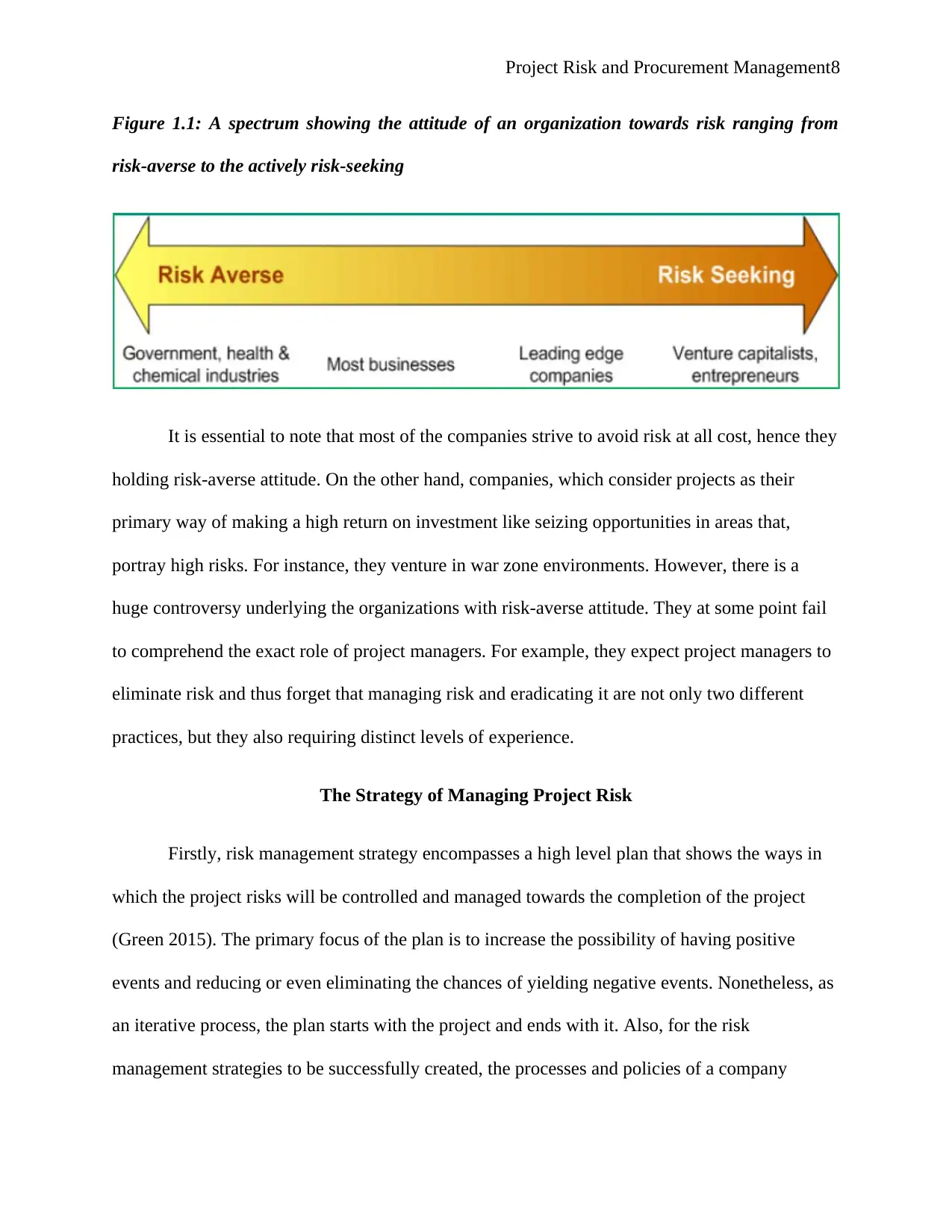
Project Risk and Procurement Management8
Figure 1.1: A spectrum showing the attitude of an organization towards risk ranging from
risk-averse to the actively risk-seeking
It is essential to note that most of the companies strive to avoid risk at all cost, hence they
holding risk-averse attitude. On the other hand, companies, which consider projects as their
primary way of making a high return on investment like seizing opportunities in areas that,
portray high risks. For instance, they venture in war zone environments. However, there is a
huge controversy underlying the organizations with risk-averse attitude. They at some point fail
to comprehend the exact role of project managers. For example, they expect project managers to
eliminate risk and thus forget that managing risk and eradicating it are not only two different
practices, but they also requiring distinct levels of experience.
The Strategy of Managing Project Risk
Firstly, risk management strategy encompasses a high level plan that shows the ways in
which the project risks will be controlled and managed towards the completion of the project
(Green 2015). The primary focus of the plan is to increase the possibility of having positive
events and reducing or even eliminating the chances of yielding negative events. Nonetheless, as
an iterative process, the plan starts with the project and ends with it. Also, for the risk
management strategies to be successfully created, the processes and policies of a company
Figure 1.1: A spectrum showing the attitude of an organization towards risk ranging from
risk-averse to the actively risk-seeking
It is essential to note that most of the companies strive to avoid risk at all cost, hence they
holding risk-averse attitude. On the other hand, companies, which consider projects as their
primary way of making a high return on investment like seizing opportunities in areas that,
portray high risks. For instance, they venture in war zone environments. However, there is a
huge controversy underlying the organizations with risk-averse attitude. They at some point fail
to comprehend the exact role of project managers. For example, they expect project managers to
eliminate risk and thus forget that managing risk and eradicating it are not only two different
practices, but they also requiring distinct levels of experience.
The Strategy of Managing Project Risk
Firstly, risk management strategy encompasses a high level plan that shows the ways in
which the project risks will be controlled and managed towards the completion of the project
(Green 2015). The primary focus of the plan is to increase the possibility of having positive
events and reducing or even eliminating the chances of yielding negative events. Nonetheless, as
an iterative process, the plan starts with the project and ends with it. Also, for the risk
management strategies to be successfully created, the processes and policies of a company

Project Risk and Procurement Management9
should be prioritized. Policies, for instance, elaborate the ways in which risk management will be
incorporated while also reinforcing the goals and objectives of the firm. The risk management
processes, on the other hand, shows the phases necessary to implement the set policies. The
progressive nature of projects subjects them to high levels of uncertainty (Green 2015). Hence,
project managers must work with a well-versed team to set competent risk management
strategies. The plan should not only be formulated well at the beginning of the project, but it
should also be advanced throughout the process. More efficient details should be incorporated in
the plan during the progress to ensure that the potential risks are not only identified, but also a
clear strategy of eliminating and reducing them is laid out. In such case, various factors are
examined by the risk management strategies. The first one is the risk areas and in particular ones
with reduced thresholds and tolerance. Secondly, the strategies address the decision makers in
the risk management. Further, an effective process set to manage risk is evaluated. Lastly, the
strategies address the objectives of risk management and the possible areas of risk that is
connected to the completion of the project. Lots of advantages accompany the creation of a
precise risk management strategy in the project’s kick off (Tang 2006).The most obvious benefit
is that the approach heightens the chances of yielding the highest performance while also
meeting the objectives of the organization.
Appropriate practices to Minimize Risks
Stanleigh (2015) defines risk management as the process of identifying, analyzing, and
also reacting to all risk factors that might alter the progress of a project in its entire lifecycle. He
also holds that risk management should operate in the interests of the project and the
organization at large. Investopedia (2015) also considers risk management as the process in
which losses are assessed, managed and even mitigated. Risk management has diverse
should be prioritized. Policies, for instance, elaborate the ways in which risk management will be
incorporated while also reinforcing the goals and objectives of the firm. The risk management
processes, on the other hand, shows the phases necessary to implement the set policies. The
progressive nature of projects subjects them to high levels of uncertainty (Green 2015). Hence,
project managers must work with a well-versed team to set competent risk management
strategies. The plan should not only be formulated well at the beginning of the project, but it
should also be advanced throughout the process. More efficient details should be incorporated in
the plan during the progress to ensure that the potential risks are not only identified, but also a
clear strategy of eliminating and reducing them is laid out. In such case, various factors are
examined by the risk management strategies. The first one is the risk areas and in particular ones
with reduced thresholds and tolerance. Secondly, the strategies address the decision makers in
the risk management. Further, an effective process set to manage risk is evaluated. Lastly, the
strategies address the objectives of risk management and the possible areas of risk that is
connected to the completion of the project. Lots of advantages accompany the creation of a
precise risk management strategy in the project’s kick off (Tang 2006).The most obvious benefit
is that the approach heightens the chances of yielding the highest performance while also
meeting the objectives of the organization.
Appropriate practices to Minimize Risks
Stanleigh (2015) defines risk management as the process of identifying, analyzing, and
also reacting to all risk factors that might alter the progress of a project in its entire lifecycle. He
also holds that risk management should operate in the interests of the project and the
organization at large. Investopedia (2015) also considers risk management as the process in
which losses are assessed, managed and even mitigated. Risk management has diverse
⊘ This is a preview!⊘
Do you want full access?
Subscribe today to unlock all pages.

Trusted by 1+ million students worldwide
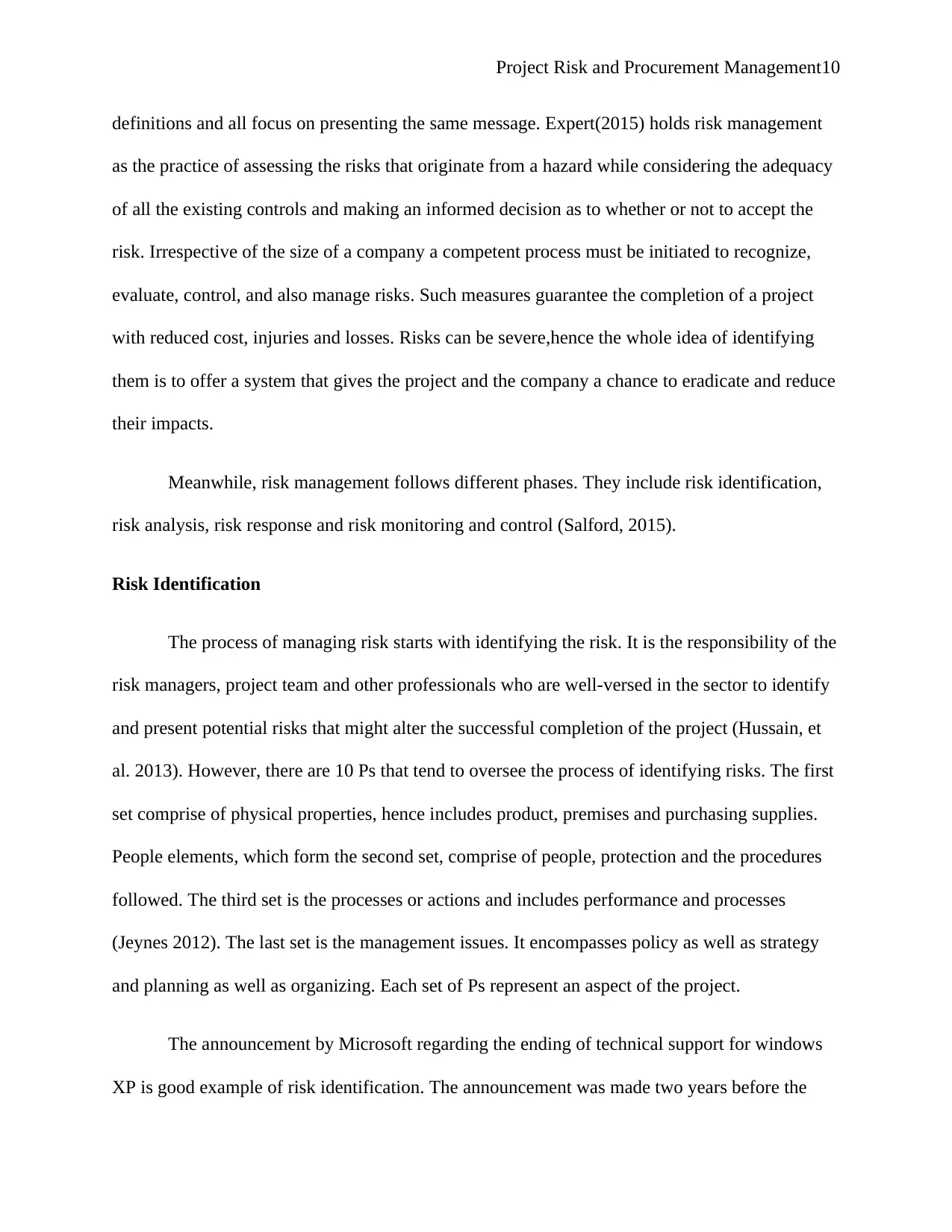
Project Risk and Procurement Management10
definitions and all focus on presenting the same message. Expert(2015) holds risk management
as the practice of assessing the risks that originate from a hazard while considering the adequacy
of all the existing controls and making an informed decision as to whether or not to accept the
risk. Irrespective of the size of a company a competent process must be initiated to recognize,
evaluate, control, and also manage risks. Such measures guarantee the completion of a project
with reduced cost, injuries and losses. Risks can be severe,hence the whole idea of identifying
them is to offer a system that gives the project and the company a chance to eradicate and reduce
their impacts.
Meanwhile, risk management follows different phases. They include risk identification,
risk analysis, risk response and risk monitoring and control (Salford, 2015).
Risk Identification
The process of managing risk starts with identifying the risk. It is the responsibility of the
risk managers, project team and other professionals who are well-versed in the sector to identify
and present potential risks that might alter the successful completion of the project (Hussain, et
al. 2013). However, there are 10 Ps that tend to oversee the process of identifying risks. The first
set comprise of physical properties, hence includes product, premises and purchasing supplies.
People elements, which form the second set, comprise of people, protection and the procedures
followed. The third set is the processes or actions and includes performance and processes
(Jeynes 2012). The last set is the management issues. It encompasses policy as well as strategy
and planning as well as organizing. Each set of Ps represent an aspect of the project.
The announcement by Microsoft regarding the ending of technical support for windows
XP is good example of risk identification. The announcement was made two years before the
definitions and all focus on presenting the same message. Expert(2015) holds risk management
as the practice of assessing the risks that originate from a hazard while considering the adequacy
of all the existing controls and making an informed decision as to whether or not to accept the
risk. Irrespective of the size of a company a competent process must be initiated to recognize,
evaluate, control, and also manage risks. Such measures guarantee the completion of a project
with reduced cost, injuries and losses. Risks can be severe,hence the whole idea of identifying
them is to offer a system that gives the project and the company a chance to eradicate and reduce
their impacts.
Meanwhile, risk management follows different phases. They include risk identification,
risk analysis, risk response and risk monitoring and control (Salford, 2015).
Risk Identification
The process of managing risk starts with identifying the risk. It is the responsibility of the
risk managers, project team and other professionals who are well-versed in the sector to identify
and present potential risks that might alter the successful completion of the project (Hussain, et
al. 2013). However, there are 10 Ps that tend to oversee the process of identifying risks. The first
set comprise of physical properties, hence includes product, premises and purchasing supplies.
People elements, which form the second set, comprise of people, protection and the procedures
followed. The third set is the processes or actions and includes performance and processes
(Jeynes 2012). The last set is the management issues. It encompasses policy as well as strategy
and planning as well as organizing. Each set of Ps represent an aspect of the project.
The announcement by Microsoft regarding the ending of technical support for windows
XP is good example of risk identification. The announcement was made two years before the
Paraphrase This Document
Need a fresh take? Get an instant paraphrase of this document with our AI Paraphraser
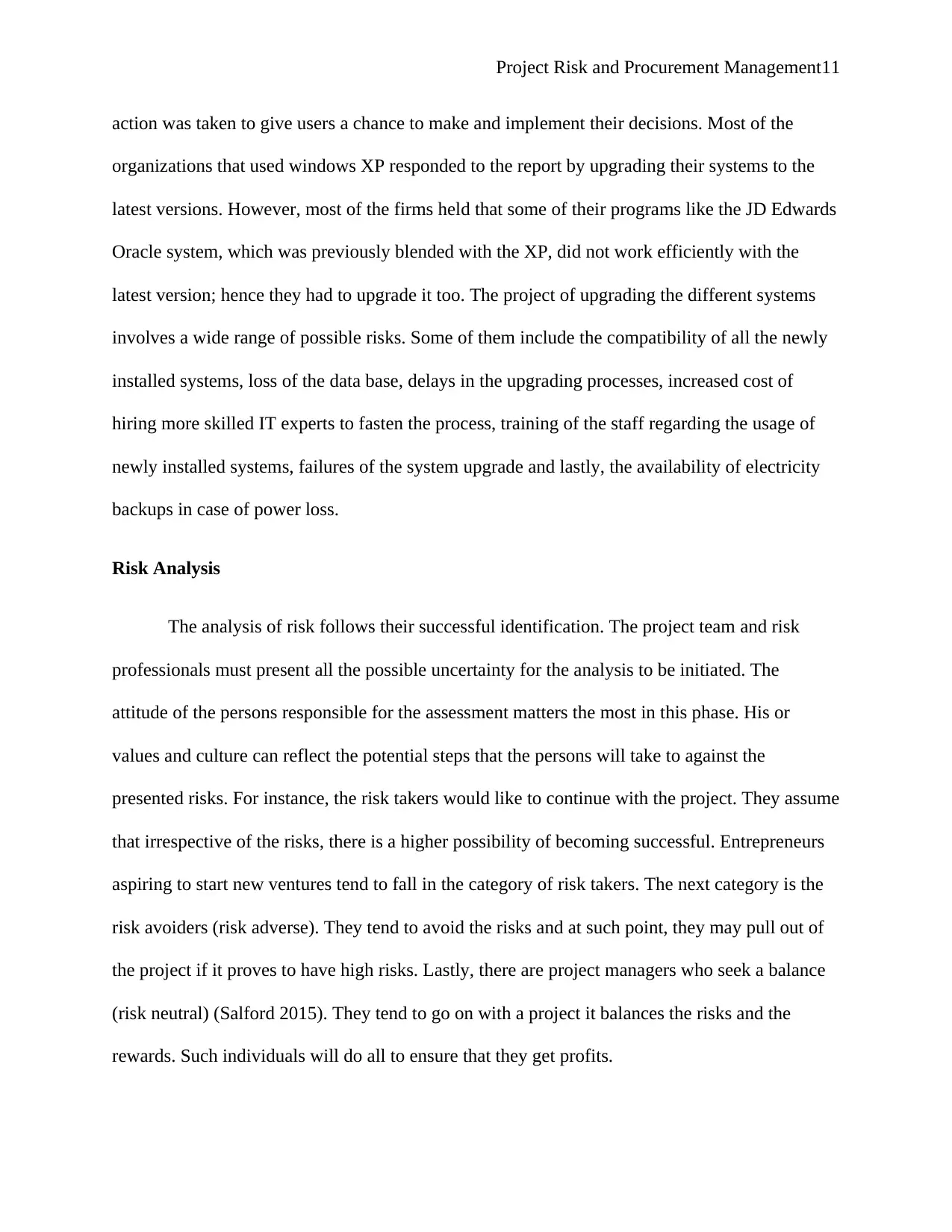
Project Risk and Procurement Management11
action was taken to give users a chance to make and implement their decisions. Most of the
organizations that used windows XP responded to the report by upgrading their systems to the
latest versions. However, most of the firms held that some of their programs like the JD Edwards
Oracle system, which was previously blended with the XP, did not work efficiently with the
latest version; hence they had to upgrade it too. The project of upgrading the different systems
involves a wide range of possible risks. Some of them include the compatibility of all the newly
installed systems, loss of the data base, delays in the upgrading processes, increased cost of
hiring more skilled IT experts to fasten the process, training of the staff regarding the usage of
newly installed systems, failures of the system upgrade and lastly, the availability of electricity
backups in case of power loss.
Risk Analysis
The analysis of risk follows their successful identification. The project team and risk
professionals must present all the possible uncertainty for the analysis to be initiated. The
attitude of the persons responsible for the assessment matters the most in this phase. His or
values and culture can reflect the potential steps that the persons will take to against the
presented risks. For instance, the risk takers would like to continue with the project. They assume
that irrespective of the risks, there is a higher possibility of becoming successful. Entrepreneurs
aspiring to start new ventures tend to fall in the category of risk takers. The next category is the
risk avoiders (risk adverse). They tend to avoid the risks and at such point, they may pull out of
the project if it proves to have high risks. Lastly, there are project managers who seek a balance
(risk neutral) (Salford 2015). They tend to go on with a project it balances the risks and the
rewards. Such individuals will do all to ensure that they get profits.
action was taken to give users a chance to make and implement their decisions. Most of the
organizations that used windows XP responded to the report by upgrading their systems to the
latest versions. However, most of the firms held that some of their programs like the JD Edwards
Oracle system, which was previously blended with the XP, did not work efficiently with the
latest version; hence they had to upgrade it too. The project of upgrading the different systems
involves a wide range of possible risks. Some of them include the compatibility of all the newly
installed systems, loss of the data base, delays in the upgrading processes, increased cost of
hiring more skilled IT experts to fasten the process, training of the staff regarding the usage of
newly installed systems, failures of the system upgrade and lastly, the availability of electricity
backups in case of power loss.
Risk Analysis
The analysis of risk follows their successful identification. The project team and risk
professionals must present all the possible uncertainty for the analysis to be initiated. The
attitude of the persons responsible for the assessment matters the most in this phase. His or
values and culture can reflect the potential steps that the persons will take to against the
presented risks. For instance, the risk takers would like to continue with the project. They assume
that irrespective of the risks, there is a higher possibility of becoming successful. Entrepreneurs
aspiring to start new ventures tend to fall in the category of risk takers. The next category is the
risk avoiders (risk adverse). They tend to avoid the risks and at such point, they may pull out of
the project if it proves to have high risks. Lastly, there are project managers who seek a balance
(risk neutral) (Salford 2015). They tend to go on with a project it balances the risks and the
rewards. Such individuals will do all to ensure that they get profits.
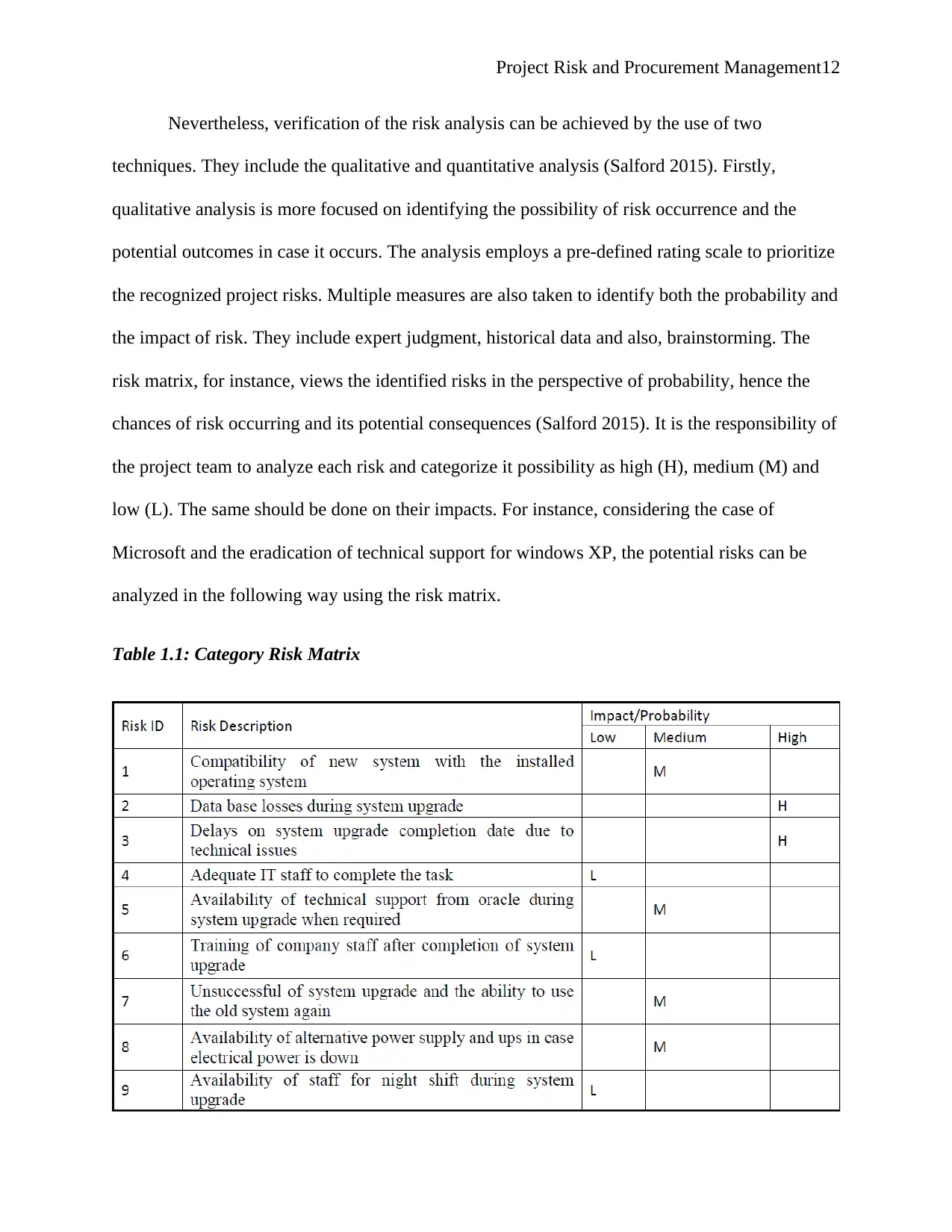
Project Risk and Procurement Management12
Nevertheless, verification of the risk analysis can be achieved by the use of two
techniques. They include the qualitative and quantitative analysis (Salford 2015). Firstly,
qualitative analysis is more focused on identifying the possibility of risk occurrence and the
potential outcomes in case it occurs. The analysis employs a pre-defined rating scale to prioritize
the recognized project risks. Multiple measures are also taken to identify both the probability and
the impact of risk. They include expert judgment, historical data and also, brainstorming. The
risk matrix, for instance, views the identified risks in the perspective of probability, hence the
chances of risk occurring and its potential consequences (Salford 2015). It is the responsibility of
the project team to analyze each risk and categorize it possibility as high (H), medium (M) and
low (L). The same should be done on their impacts. For instance, considering the case of
Microsoft and the eradication of technical support for windows XP, the potential risks can be
analyzed in the following way using the risk matrix.
Table 1.1: Category Risk Matrix
Nevertheless, verification of the risk analysis can be achieved by the use of two
techniques. They include the qualitative and quantitative analysis (Salford 2015). Firstly,
qualitative analysis is more focused on identifying the possibility of risk occurrence and the
potential outcomes in case it occurs. The analysis employs a pre-defined rating scale to prioritize
the recognized project risks. Multiple measures are also taken to identify both the probability and
the impact of risk. They include expert judgment, historical data and also, brainstorming. The
risk matrix, for instance, views the identified risks in the perspective of probability, hence the
chances of risk occurring and its potential consequences (Salford 2015). It is the responsibility of
the project team to analyze each risk and categorize it possibility as high (H), medium (M) and
low (L). The same should be done on their impacts. For instance, considering the case of
Microsoft and the eradication of technical support for windows XP, the potential risks can be
analyzed in the following way using the risk matrix.
Table 1.1: Category Risk Matrix
⊘ This is a preview!⊘
Do you want full access?
Subscribe today to unlock all pages.

Trusted by 1+ million students worldwide
1 out of 20
Related Documents
Your All-in-One AI-Powered Toolkit for Academic Success.
+13062052269
info@desklib.com
Available 24*7 on WhatsApp / Email
![[object Object]](/_next/static/media/star-bottom.7253800d.svg)
Unlock your academic potential
Copyright © 2020–2025 A2Z Services. All Rights Reserved. Developed and managed by ZUCOL.





